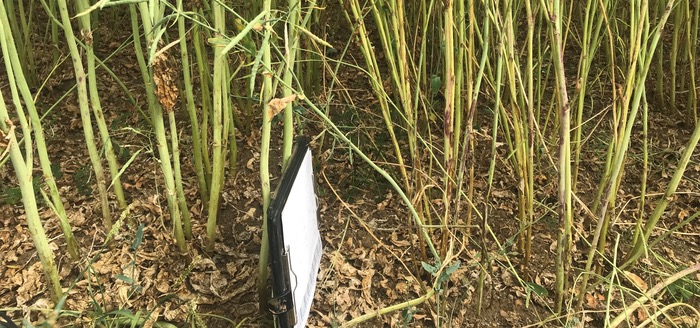Arable plant pathologist, Philip Walker of ADAS Boxworth reminds growers that there is still no chemical treatment for verticillium stripe (previously known as Verticillium wilt) in oilseed rape, so “we have to rely on variety resistance.”
“We are getting more reports of Verticillium stripe these days, as people get to know more about it and can identify the symptoms they are looking for in the field. This year verticillium symptom expression was seen at the time desiccants were applied and this disease was at a reasonably high level. In the field you start by seeing premature ripening which is indicative of disease such as Verticillium stripe and which gets more obvious as the crop matures. Verticillium affects the whole of the plant architecture, showing as yellow or brown discolouration on the stem surface, and if you peel back the epidermis of the stem you will see grey vertical stripes running through the stem tissue, which is the infection found in the xylem or water conducting parts of the stem. As the crop senesces, these grey vertical stripes will form tiny black dots called microsclerotia, which can be seen using a hand lens, and will return verticillium infection back into the soil. You can certainly see the symptoms in the susceptible varieties now.”
“In one of our trials on a known disease site in Cambridgeshire, the susceptible varieties were scoring a high 70 Index which means 70% of the plants were dead from verticillium. On the more tolerant varieties we were seeing much lower scores of 20.”
“The AHDB trials are looking at Verticillium resistance this year in the hopes of being able to add this to their Recommended List in the future. Their trials data is yet to be published but I am sure when there is a sufficient data set the List will include Verticillium ratings. This is expected to be introduced soon,.” says Mr Walker.
Neil Groom, general manager of Grainseed is anxious to show off their wares as Grainseed’s rape varieties show strong resistance to Verticillium stripe. “Visiting trials sites very recently have shown that our new variety Pinnacle was looking very clean and free from Vertcilliium.”
To manage Verticillium stripe, you need resistant varieties. According to Mr Walker, “There is no chemical option and as far as I am aware no chemicals are currently being tested for its control.”
“As Philip says, there is no other real option than growing a resistant variety,” says Mr Groom. “Once you have identified this disease on your farm, you need to plant a variety with known proven resistance. Trials show distinct differences in susceptibilities between oilseed rape varieties. Tested on sites with known verticillium infection, varieties such as Quartz and Harper are classified as susceptible. Grainseed oilseed rape varieties such as Pinnacle and Mambo have proven resistance to verticillium, following several years’ independent trials and commercial experience. Mambo has been the most resistant variety in AICC trials.”
Reported in Cambridgeshire and the east
“Extending the rotation as a means of controlling the disease is impractical as the microsclerotia can survive in the soil for at least 10 years. They germinate in the autumn in response to root exudates from newly planted rape crops and invade the roots of oilseed rape seedlings. The crop shows no symptoms at this early stage. At stem extension the infection spreads from the roots into the vascular system, colonising the stem. This causes premature ripening and yield reduction, explains Mr Walker. Verticillium has been reported this year in particular hotspots such as in Cambridgeshire and the East,but has also been reported in other oilseed rape growing areas of Lincolnshire and Herefordshire.
Mr Walker advises a rotation of at least 1 in 5 for verticillium as well as Sclerotinia in rape. “When monitoring levels in the soil, there is decline over time, but it rarely gets to zero. Even fields that had a 5-year break from growing oilseed rape can suffer from verticillium if that field was previously affected” he says.
“For those who have seen verticillium this harvest, the only control option in the foreseeable future is to grow a resistant variety on that field,” Mr Walker says. “There are significant differences in verticillium resistance between varieties, with many of the more modern varieties with high vigour, and good standing power being able to compensate for or tolerate this disease, even where a high degree of infection is seen.”
Growing a variety with strong all-round disease resistance can save money, but of course variety selection is made prior to drilling. “Once the crop is in the ground, there is nothing else you can do to control verticillium,” says Mr Groom. “Working with plant breeder Mike Pickford over the last 5 years, we have been focussing on breeding clean varieties for the UK to enable growers to reduce inputs, reduce risk of weather delays in fungicide application and improve genetic resistance.”
“Pinnacle is one of these clean varieties and growers will notice its greener stems at harvest. This helps the plants keep photosynthesising and building yield and results in very large seed at harvest,” explains Mr Pickford.




